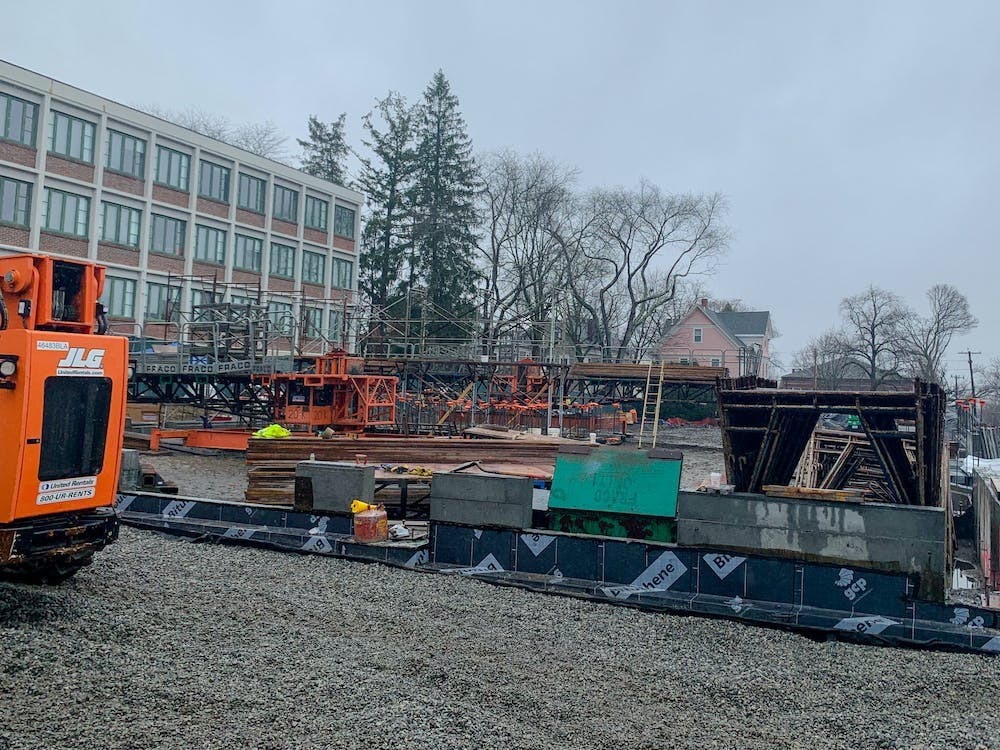With the signing of a memorandum of understanding Nov. 14, the University has committed to employing all-union labor for any construction project over $25 million for the next five years as part of an agreement with the Rhode Island Building and Construction Trades Council, according to a press release.
The memorandum also reiterates a preexisting requirement that 15% of labor hours be worked by graduates of Building Futures, a construction apprenticeship program in which low-income Rhode Islanders learn certain trades while working and earning wages. The University has since 2013 required a Building Futures involvement in projects over $5 million.
“This milestone marks Brown’s standing commitment to ensuring that campus development serves as a regional economic engine and a career catalyst for local construction workers,” Vice President for Facilities Management Michael Guglielmo Jr. said at the signing ceremony, which took place at the Granoff Center for the Creative Arts.
During the ceremony, President Christina Paxson P’19 said that the memorandum will ensure that the “strong relationship between Brown and the Building and Construction Trades Council will continue on into the coming years.” She said that the memorandum will govern the construction of the new integrated life sciences building in the Jewelry District. Currently, the Lindemann Performing Arts Center and the residence halls on Brook Street are being completed under earlier project labor memorandums.
Negotiations for the memorandum only took “a few months,” Guglielmo wrote in an email to The Herald. The terms and conditions included in the memorandum had already been negotiated in prior project memorandums, he said, adding that the University has built 19 projects that cost over $25 million over the past two decades.
RIBCTC President Michael Sabitoni said that RIBCTC and Building Futures first approached the University about the memorandum in 2007, the year Building Futures began its operations. The organizations argued that the agreement made sense given Brown’s consistent construction schedule and the alignment of Building Futures’ purpose with Brown’s long-term mission of supporting Providence.
Sabitoni said that the memorandum finally came to fruition after Building Futures had demonstrated the long-term success of their program and proved that the memorandum would benefit Brown, construction workers, the community and the local economy.
“I think everybody should be damn proud of what was accomplished,” he said.
Sabitoni explained that the memorandum’s application to projects over $25 million is significant: Projects worth more than $25 million are more complex, requiring more people and interactions with subcontractors, he said. While the memorandum applies to all projects over $25 million, the University and RIBCTC will still discuss the individual circumstances of each project, Sabitoni said.
Andrew Cortés, executive director of Building Futures, said that he knows the power of the organization’s apprenticeship model because it is what brought him out of poverty and into the middle class. “Many people, unfortunately, are not in a position where they can pay to learn and then get their job. They need to earn and learn at the same time,” he said.
Building Futures has a mission to help workers from disadvantaged economic conditions, said Cortés. He reported that all participants are considered low-income upon entry into the program, 77% of their graduates are people of color, 10% are women and 40% are formerly incarcerated.
Cortés explained that Building Futures seeks to stop the “revolving door” of recidivism. For many formerly incarcerated people, “there’s no economic opportunity. They fall back to whatever it was that put them in prison in the first place,” he said.
A Rhode Island Department of Corrections study from March 2021 found that three years after individuals were released, 47% returned to RIDOC as sentenced offenders.
“Somebody who finds a pathway to economic stability and a genuine career that takes you to the middle class and supports families doesn’t reoffend,” Cortés said, noting that less than 3% of program participants who were formerly incarcerated have returned to the criminal justice system.
Sabitoni still expects Brown to work with Building Futures and the RIBCTC on projects that technically fall outside of the parties’ existing agreements. Brown has “a beautiful campus,” he said. “We've built that campus for decades.”
The University has entered labor agreements on a case-by-case basis, but has used such agreements on projects worth over $350 million over the last 20 years, according to the press release.
Sabitoni said the memorandum shows the institutions’ commitment to each other and Brown’s commitment to Providence's future, adding that he hopes that it will encourage other institutions to enter into similar agreements.
Memorandums like this one allow union members to have more job security and certainty, Cortés said.
Guglielmo wrote that the memorandum will likely save the University two to three months on average per project.
Cortés said he hopes to expand Building Futures’ programming in the future to serve more community members.
“We have communities that really need economic opportunity,” Cortés said, adding that for every class of 16 apprentices, there are about 100 people interested in learning through the program.
“Union tradesmen and women have worked on virtually every major capital construction project at Brown,” he added. “Project labor memorandums have also played and are playing a critical role in Brown's growth.”

Elysée is a writer for metro, a producer for the Bruno Brief podcast and an aspiring card game creator. She is a second-year student studying International and Public Affairs on the Policy and Governance Track.





